Hearing
audition the sense or act of hearing.
Like our other senses, our audition, or hearing, helps us adapt and survive. Hearing people share information invisibly—
Most of us, however, can hear a wide range of sounds, and the ones we hear best are those in the range of the human voice. With normal hearing, we are remarkably sensitive to faint sounds, such as a child’s whimper. (If our ears were only slightly more sensitive, we would hear a constant hiss from the movement of air molecules.) We are also remarkably attuned to sound variations. Among thousands of possible human voices, we easily recognize an unseen friend’s, from the moment she says “Hi.” Moreover, hearing is fast. “It might take you a full second to notice something out of the corner of your eye, turn your head toward it, recognize it, and respond to it,” notes auditory neuroscientist Seth Horowitz (2012). “The same reaction to a new or sudden sound happens at least 10 times as fast.” A fraction of a second after such events stimulate the ear’s receptors, millions of neurons have simultaneously coordinated in extracting the essential features, comparing them with past experience, and identifying the stimulus (Freeman, 1991). For hearing as for our other senses, we wonder: How do we do it?
The Stimulus Input: Sound Waves
6-
Draw a bow across a violin, and you will unleash the energy of sound waves. Jostling molecules of air, each bumping into the next, create waves of compressed and expanded air, like the ripples on a pond circling out from a tossed stone. As we swim in our ocean of moving air molecules, our ears detect these brief air pressure changes.
frequency the number of complete wavelengths that pass a point in a given time (for example, per second).
pitch a tone’s experienced highness or lowness; depends on frequency.
Like light waves, sound waves vary in shape (FIGURE 6.35). The height, or amplitude, of sound waves determines their loudness. Their length, or frequency, determines the pitch we experience. Long waves have low frequency—
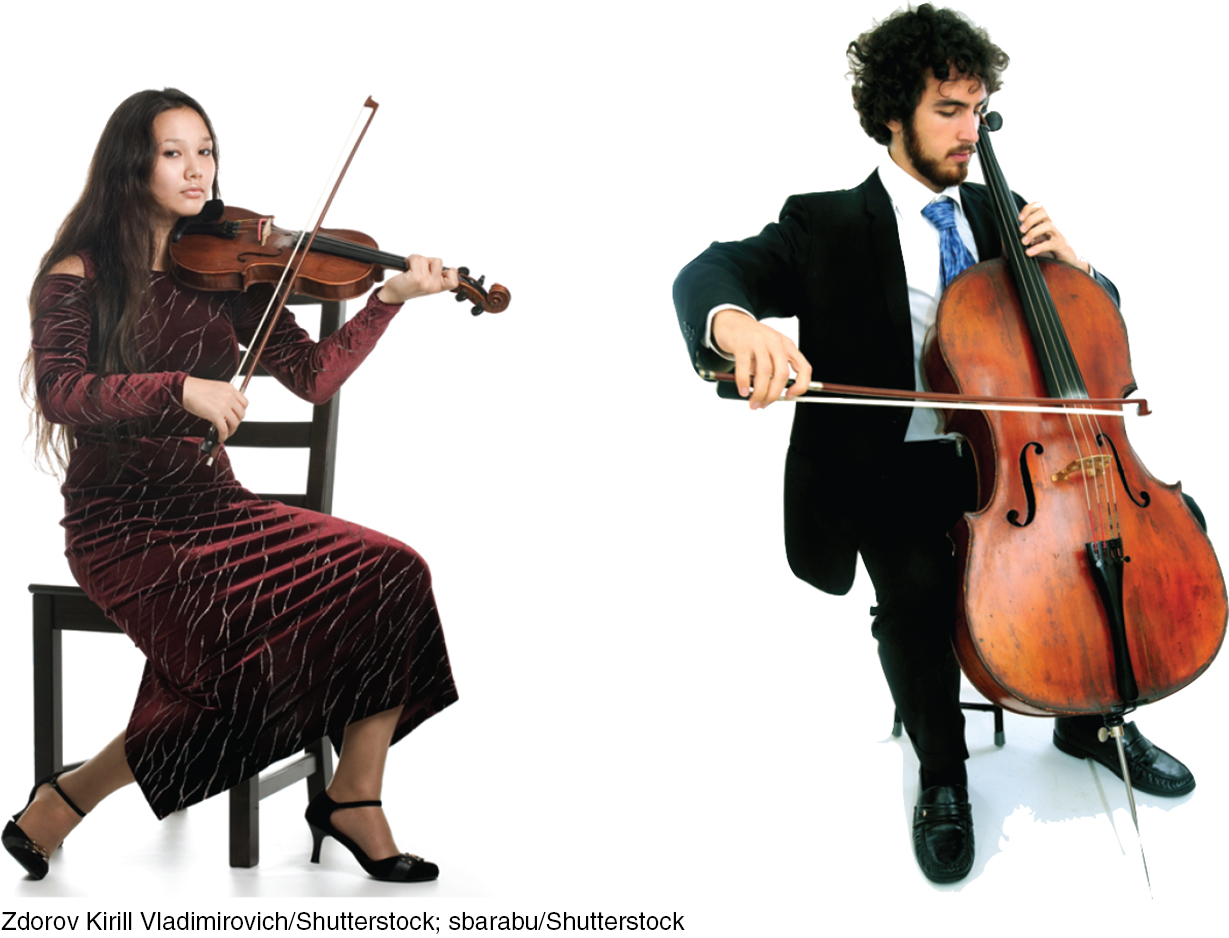
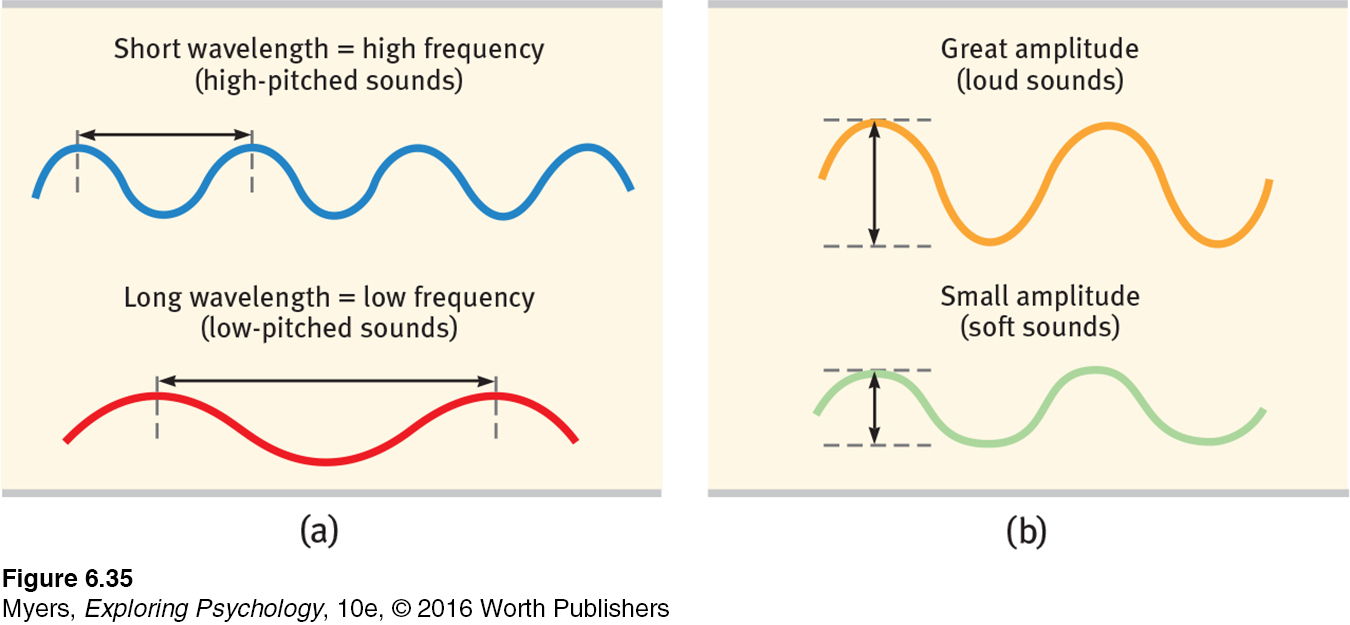
We measure sounds in decibels, with zero decibels representing the absolute threshold for hearing. Every 10 decibels correspond to a tenfold increase in sound intensity. Thus, normal conversation (60 decibels) is 10,000 times more intense than a 20-
The Ear
6-
middle ear the chamber between the eardrum and cochlea containing three tiny bones (hammer, anvil, and stirrup) that concentrate the vibrations of the eardrum on the cochlea’s oval window.
The intricate process that transforms vibrating air into nerve impulses, which our brain decodes as sounds, begins when sound waves enter the outer ear. An elaborate mechanical chain reaction begins as the visible outer ear channels the waves through the auditory canal to the eardrum, a tight membrane, causing it to vibrate (FIGURE 6.36). In the middle ear, a piston made of three tiny bones (the hammer, anvil, and stirrup) picks up the vibrations and transmits them to the cochlea, a snail-
cochlea [KOHK-
inner ear the innermost part of the ear, containing the cochlea, semicircular canals, and vestibular sacs.
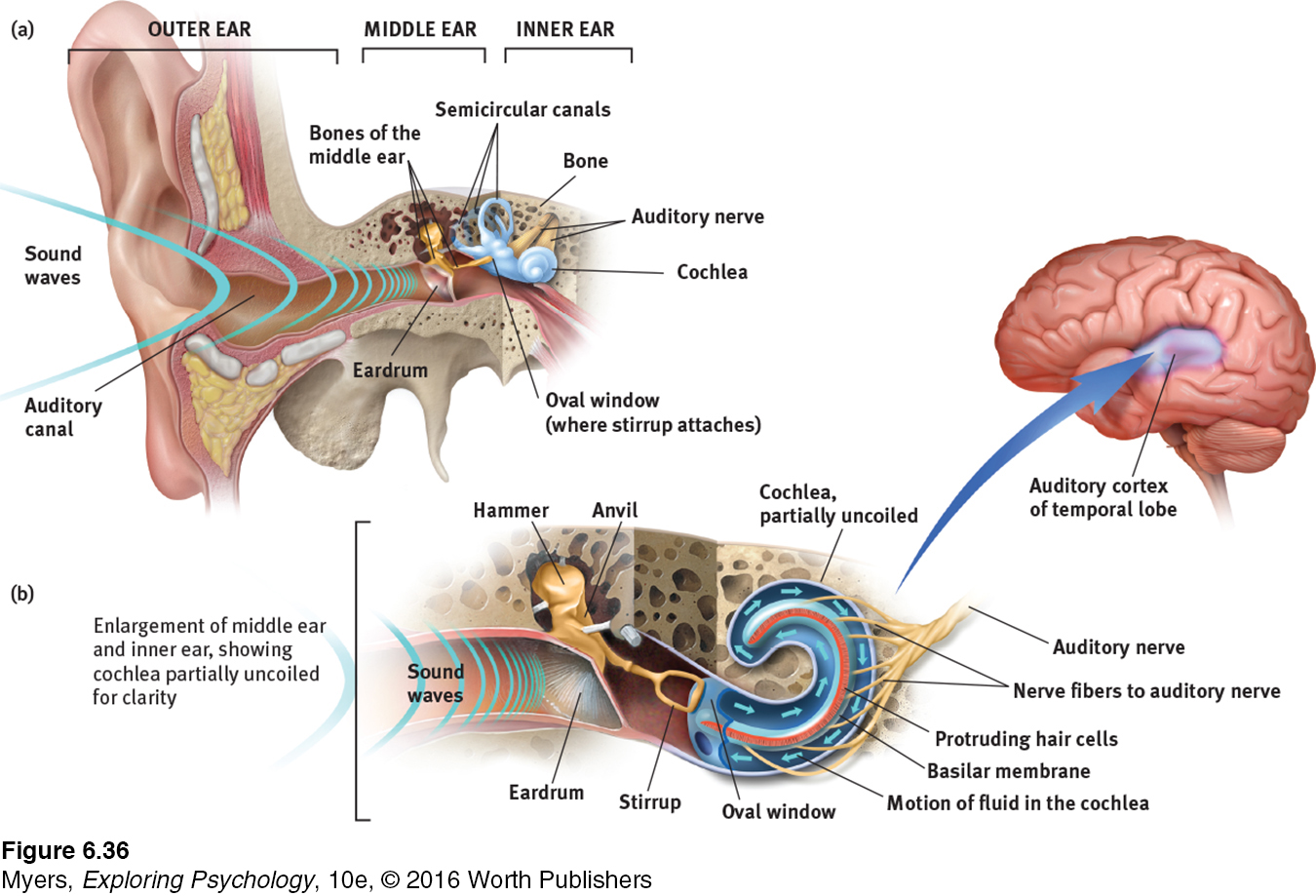
Perhaps the most intriguing part of the hearing process is the hair cells—
sensorineural hearing loss the most common form of hearing loss, also called nerve deafness; caused by damage to the cochlea’s receptor cells or to the auditory nerves.
conduction hearing loss less common form of hearing loss, caused by damage to the mechanical system that conducts sound waves to the cochlea.
Across the world, 360 million people are challenged by hearing loss (WHO, 2012). Damage to the cochlea’s hair cell receptors or their associated nerves can cause sensorineural hearing loss (or nerve deafness). Occasionally, disease damages these receptors, but more often the culprits are biological changes linked with heredity, aging, and prolonged exposure to ear-
The cochlea’s hair cells have been likened to carpet fibers. Walk around on them and they will spring back. But leave a heavy piece of furniture on them and they may never rebound. As a general rule, if we cannot talk over a noise, it is potentially harmful, especially if prolonged and repeated (Roesser, 1998). Such experiences are common when sound exceeds 100 decibels, as might occur when in a frenzied sports arena, playing loud music through headphones, or listening to bagpipes (FIGURE 6.37). Ringing of the ears after exposure to loud sounds indicates that we have been bad to our unhappy hair cells. One study of teen rock concert attendees found that after three hours of sound averaging 99 decibels, 54 percent reported not hearing as well, and 1 in 4 had ringing in their ears. As pain alerts us to possible bodily harm, ringing of the ears alerts us to possible hearing damage. It is hearing’s equivalent of bleeding.
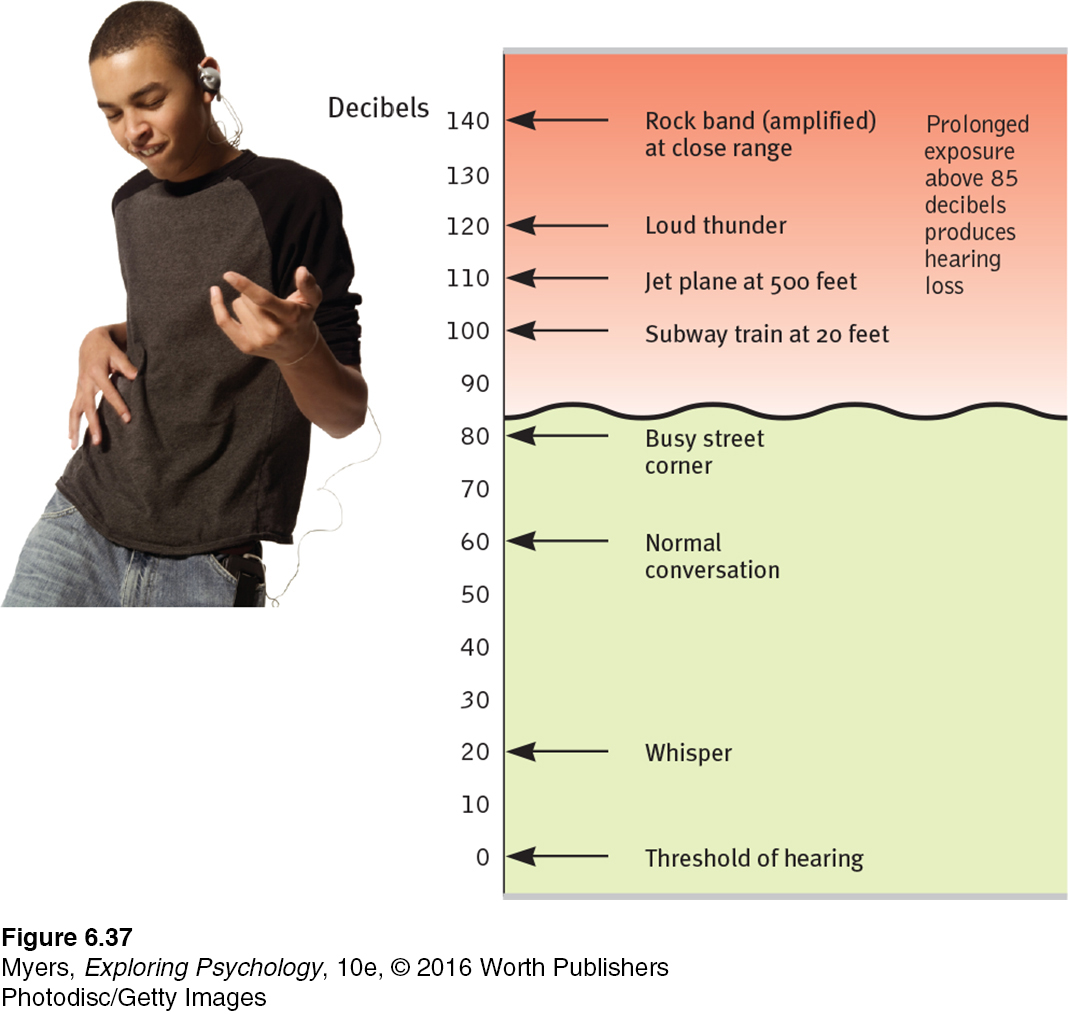
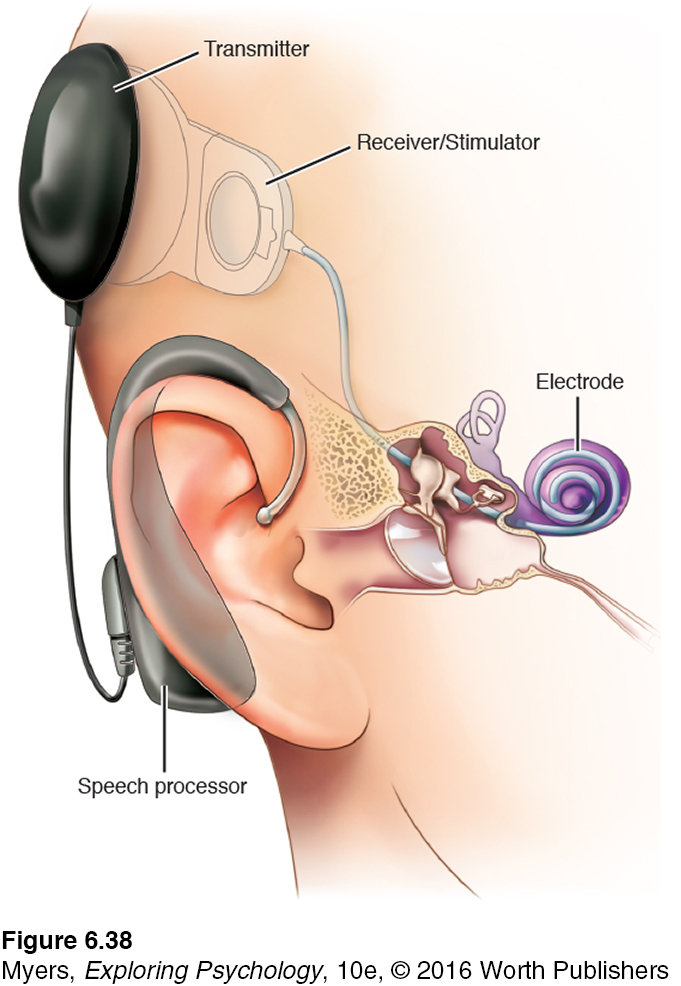
The rate of teen hearing loss, now 1 in 5, has risen by a third since the early 1990s (Shargorodsky et al., 2010). Teen boys more than teen girls or adults blast themselves with loud volumes for long periods (Zogby, 2006). Males’ greater noise exposure may help explain why men’s hearing tends to be less acute than women’s. But regardless of gender, those who spend many hours in a loud nightclub, behind a power mower, or above a jackhammer should wear earplugs. “Condoms or, safer yet, abstinence,” say sex educators. “Earplugs or walk away,” say hearing educators.
cochlear implant a device for converting sounds into electrical signals and stimulating the auditory nerve through electrodes threaded into the cochlea.
For now, the only way to restore hearing for people with nerve deafness is a sort of bionic ear—
RETRIEVE IT
Question
The amplitude of a sound wave determines our perception of ________ (loudness/pitch).
Question
The longer the sound waves are, the ________ (lower/higher) their frequency is and the ________ (lower/higher) their pitch.
Perceiving Loudness, Pitch, and Location
6-
RESPONDING TO LOUD AND SOFT SOUNDS How do we detect loudness? If you guessed that it’s related to the intensity of a hair cell’s response, you’d be wrong. Rather, a soft, pure tone activates only the few hair cells attuned to its frequency. Given louder sounds, neighboring hair cells also respond. Thus, your brain interprets loudness from the number of activated hair cells.
If a hair cell loses sensitivity to soft sounds, it may still respond to loud sounds. This helps explain another surprise: Really loud sounds may seem loud to people with or without normal hearing. As a person with hearing loss, I [DM] used to wonder what really loud music must sound like to people with normal hearing. Now I realize it sounds much the same; where we differ is in our perception of soft sounds.
HEARING DIFFERENT PITCHES How do we know whether a sound is the high-
place theory in hearing, the theory that links the pitch we hear with the place where the cochlea’s membrane is stimulated.
frequency theory in hearing, the theory that the rate of nerve impulses traveling up the auditory nerve matches the frequency of a tone, thus enabling us to sense its pitch. (Also called temporal theory.)
Hermann von Helmholtz’s place theory presumes that we hear different pitches because different sound waves trigger activity at different places along the cochlea’s basilar membrane. Thus, the brain determines a sound’s pitch by recognizing the specific place (on the membrane) that is generating the neural signal. When Nobel laureate-
to- be Georg von Békésy (1957) cut holes in the cochleas of guinea pigs and human cadavers and looked inside with a microscope, he discovered that the cochlea vibrated, rather like a shaken bedsheet, in response to sound. High frequencies produced large vibrations near the beginning of the cochlea’s membrane. Low frequencies vibrated more of the membrane and were not so neatly localized. So, the problem remains: Place theory can explain how we hear high- pitched sounds, but not low- pitched sounds. Page 230Frequency theory (also called temporal theory) suggests an alternative: The brain reads pitch by monitoring the frequency of neural impulses traveling up the auditory nerve. The whole basilar membrane vibrates with the incoming sound wave, triggering neural impulses to the brain at the same rate as the sound wave. If the sound wave has a frequency of 100 waves per second, then 100 pulses per second travel up the auditory nerve. But again, a problem remains: An individual neuron cannot fire faster than 1000 times per second. How, then, can we sense sounds with frequencies above 1000 waves per second (roughly the upper third of a piano keyboard)?
Enter the volley principle: Like soldiers who alternate firing so that some can shoot while others reload, neural cells can alternate firing. By firing in rapid succession, they can achieve a combined frequency above 1000 waves per second.
 For an interactive review of how we perceive sound, visit LaunchPad’s PsychSim 6: The Auditory System. For an animated explanation, visit LaunchPad’s Concept Practice: The Auditory Pathway.
For an interactive review of how we perceive sound, visit LaunchPad’s PsychSim 6: The Auditory System. For an animated explanation, visit LaunchPad’s Concept Practice: The Auditory Pathway.
So, here is our current thinking on how we discriminate pitch:
Place theory best explains how we sense high pitches.
Frequency theory, extended by the volley principle, best explains how we sense low pitches.
Some combination of place and frequency theories seems to handle the pitches in the intermediate range.
RETRIEVE IT
Question
Which theory of pitch perception would best explain a symphony audience's enjoyment of a high-
LOCATING SOUNDS Why don’t we have one big ear—
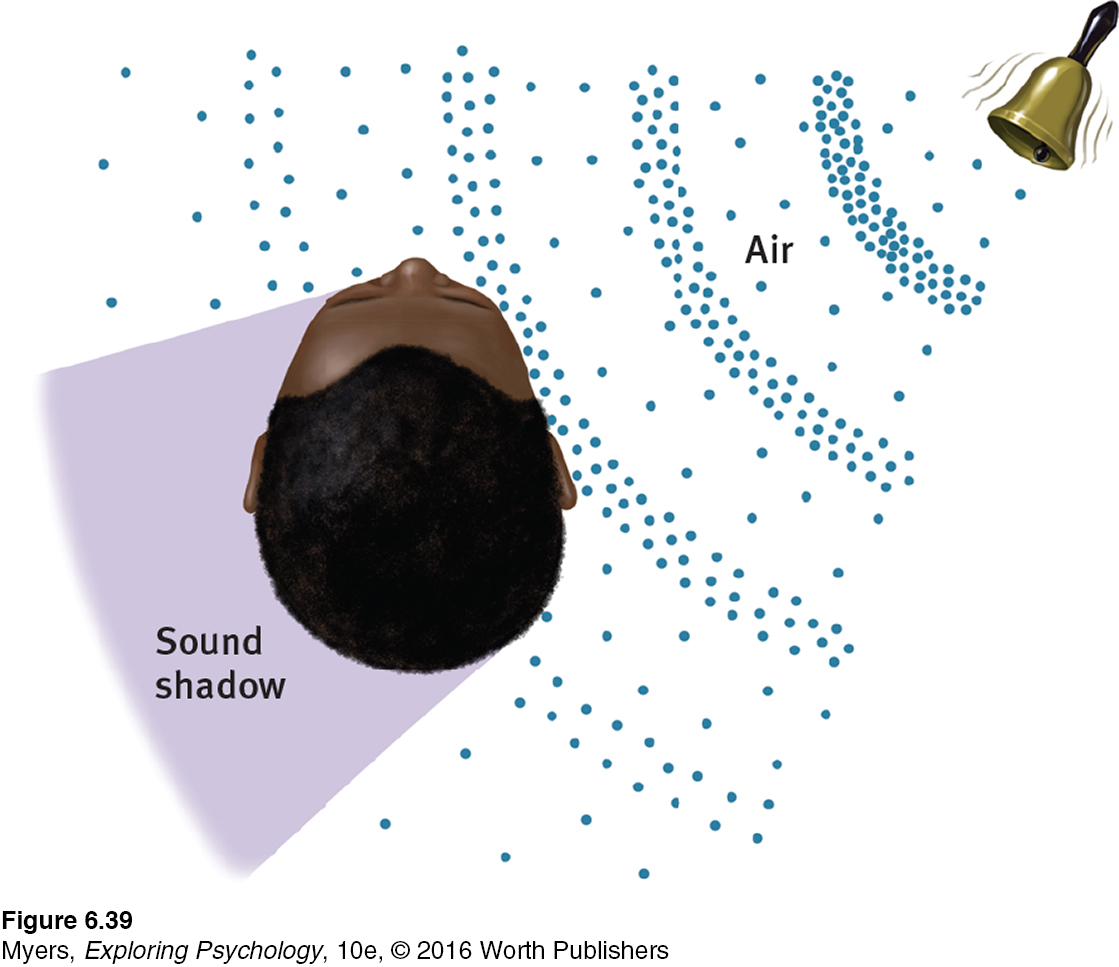
The Other Senses
Sharks and dogs rely on their outstanding sense of smell, aided by large brain areas devoted to this system. Our human brain gives seeing and hearing priority in the allocation of cortical tissue. But extraordinary happenings also occur within our other senses. Without our senses of touch, taste, smell, and body position and movement, we humans would be seriously handicapped, and our capacities for enjoying the world would be greatly diminished.
Touch
6-
Touch is vital. Right from the start, touch aids our development. Infant rats deprived of their mother’s grooming produce less growth hormone and have a lower metabolic rate—

Humorist Dave Barry was perhaps right to jest that your skin “keeps people from seeing the inside of your body, which is repulsive, and it prevents your organs from falling onto the ground.” But skin does much more. Touching various spots on the skin with a soft hair, a warm or cool wire, and the point of a pin reveals that some spots are especially sensitive to pressure, others to warmth, others to cold, still others to pain. Our “sense of touch” is actually a mix of these four basic and distinct skin senses, and our other skin sensations are variations of pressure, warmth, cold, and pain. Some examples:
Stroking adjacent pressure spots creates a tickle.
Repeated gentle stroking of a pain spot creates an itching sensation.
Touching adjacent cold and pressure spots triggers a sense of wetness, which you can experience by touching dry, cold metal.
Touch sensations involve more than tactile stimulation, however. A self-
Pain
6-
Be thankful for occasional pain. Pain is your body’s way of telling you something has gone wrong. By drawing your attention to a burn, a break, or a sprain, pain orders you to change your behavior—
More numerous are those who live with chronic pain, which is rather like an alarm that won’t shut off. The suffering of those with persistent or recurring backaches, arthritis, headaches, and cancer-
UNDERSTANDING PAIN Our pain experiences vary widely. Women are more sensitive to pain than men are (their senses of hearing and smell also tend to be more sensitive) (Ruau et al., 2012; Wickelgren, 2009). Our individual pain sensitivity varies, too, depending on genes, physiology, experience, attention, and surrounding culture (Gatchel et al., 2007; Reimann et al., 2010). Thus, our experience of pain reflects both bottom-
BIOLOGICAL INFLUENCES There is no one type of stimulus that triggers pain (as light triggers vision). Instead, there are different nociceptors—
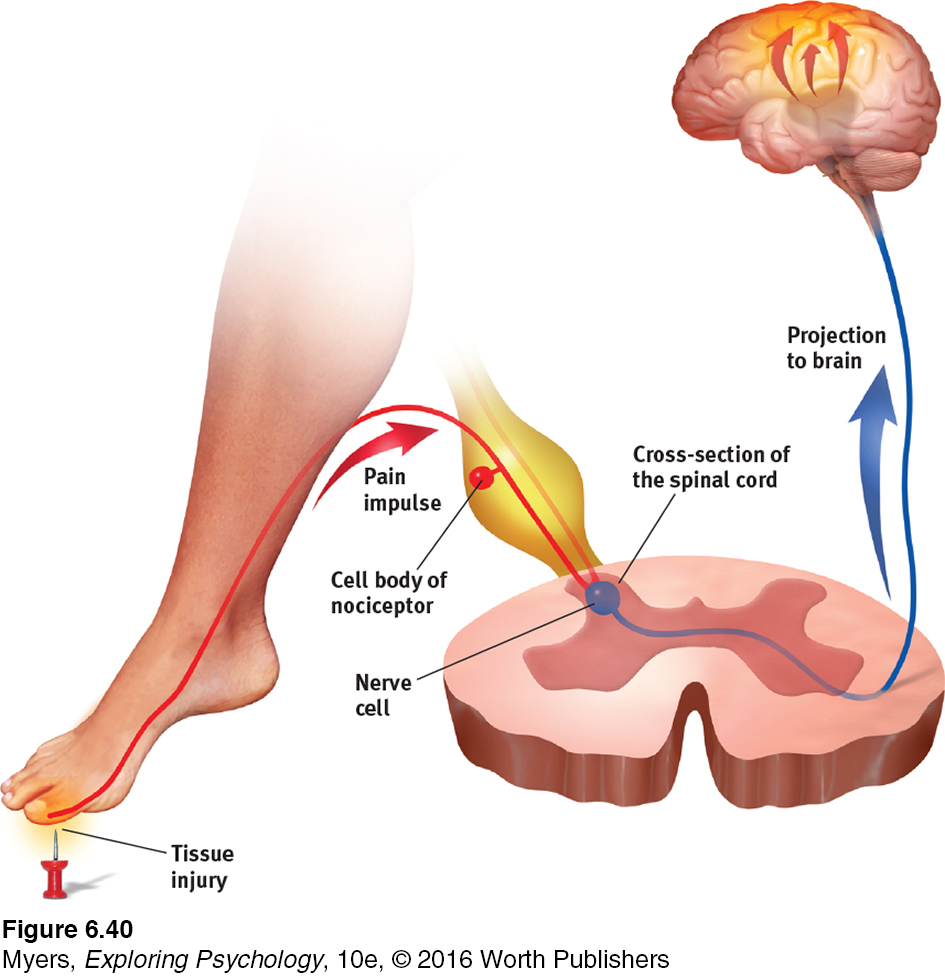
gate-control theory the theory that the spinal cord contains a neurological “gate” that blocks pain signals or allows them to pass on to the brain. The “gate” is opened by the activity of pain signals traveling up small nerve fibers and is closed by activity in larger fibers or by information coming from the brain.
Although no theory of pain explains all available findings, psychologist Ronald Melzack and biologist Patrick Wall’s (1965, 1983; Melzack & Katz, 2013) classic gate-control theory provides a useful model. The spinal cord contains small nerve fibers that conduct most pain signals, and larger fibers that conduct most other sensory signals. Melzack and Wall theorized that the spinal cord contains a neurological “gate.” When tissue is injured, the small fibers activate and open the gate, and you feel pain. Large-
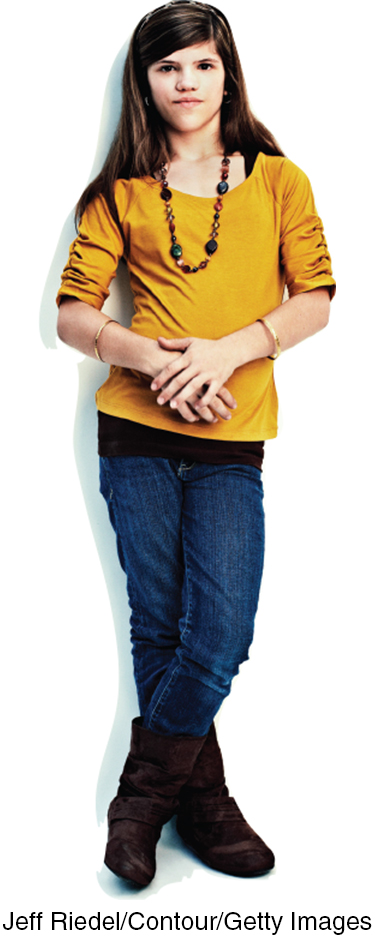
But pain is not merely a physical phenomenon of injured nerves sending impulses to a definable brain area—
Phantoms may haunt other senses too, as the brain, responding to the absence of sensory signals, amplifies irrelevant neural activity. People with hearing loss often experience the sound of silence: tinnitus, the phantom sound of ringing in the ears. Those who lose vision to glaucoma, cataracts, diabetes, or macular degeneration may experience phantom sights—
PSYCHOLOGICAL INFLUENCES One powerful influence on our perception of pain is the attention we focus on it. Athletes, focused on winning, may play through the pain. Halfway through his lap of the 2012 Olympics 1600-
We also seem to edit our memories of pain, which often differ from the pain we actually experienced. In experiments, and after medical procedures, people overlook a pain’s duration. Their memory snapshots instead record two factors: their pain’s peak moment (which can lead them to recall variable pain, with peaks, as worse [Stone et al., 2005]), and how much pain they felt at the end. In one experiment, researchers asked people to immerse one hand in painfully cold water for 60 seconds, and then the other hand in the same painfully cold water for 60 seconds followed by a slightly less painful 30 seconds more (Kahneman et al., 1993). Which experience would you expect to recall as most painful?
Curiously, when asked which trial they would prefer to repeat, most preferred the 90-
The end of an experience can color our memory of pleasures, too. In one simple experiment, some people, on receiving a fifth and last piece of chocolate, were told it was their “next” one. Others, told it was their “last” piece, liked it better and also rated the whole experiment as being more enjoyable (O’Brien & Ellsworth, 2012). Endings matter.

SOCIAL-
Thus, our perception of pain is a biopsychosocial phenomenon (Hadjistavropoulos et al., 2011). Viewing pain from many perspectives can help us better understand how to cope with it and treat it (FIGURE 6.41).
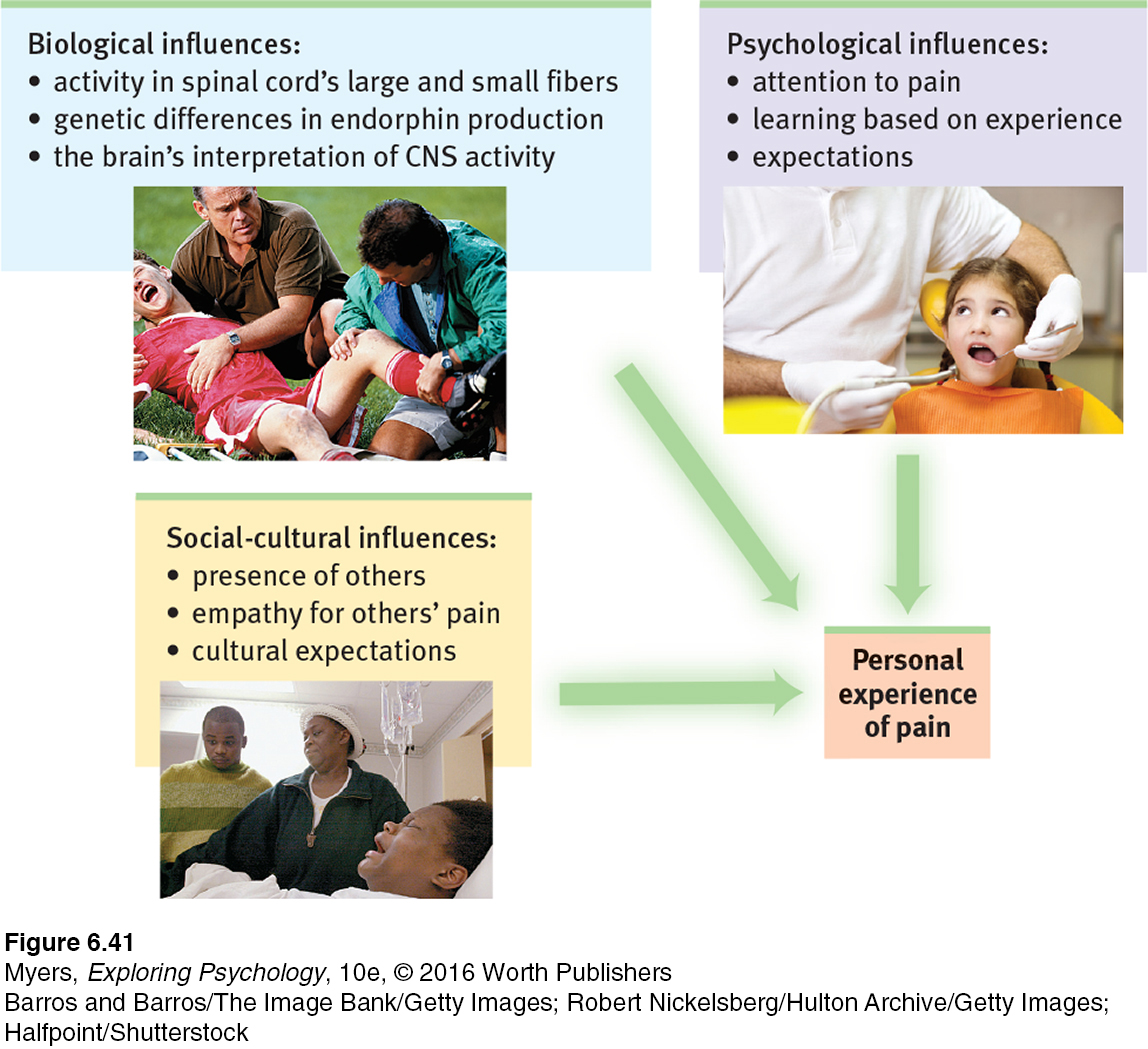

CONTROLLING PAIN If pain is where body meets mind—
These options reflect some striking influences on pain. When we are distracted from pain (a psychological influence) and soothed by the release of our naturally painkilling endorphins (a biological influence), our experience of pain diminishes. Sports injuries may go unnoticed until the after-
PLACEBOS Even an inert placebo can help, by dampening the central nervous system’s attention and responses to painful experiences—
“Pain is increased by attending to it.”
Charles Darwin, The Expression of the Emotions in Man and Animals, 1872
DISTRACTION Distracting people with pleasant images (“Think of a warm, comfortable environment”) or drawing their attention away from painful stimulation (“Count backward by 3’s”) is an effective way to activate pain-
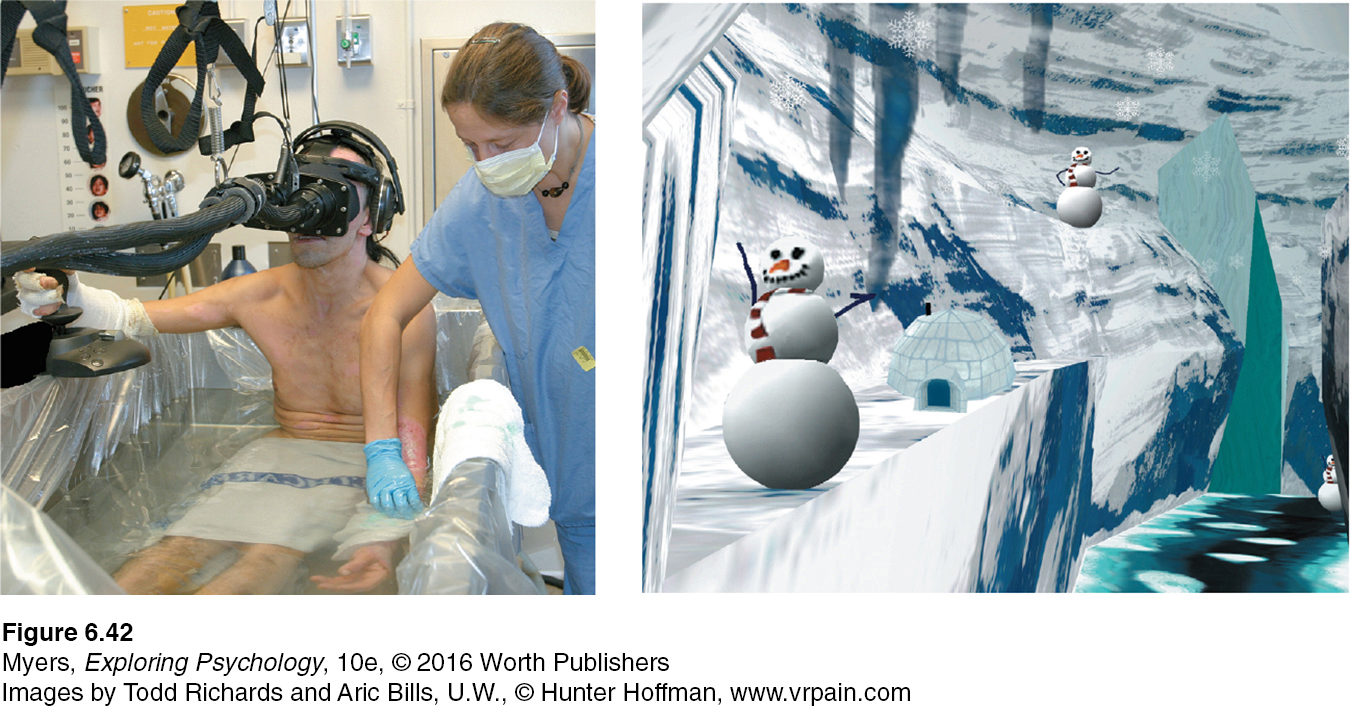
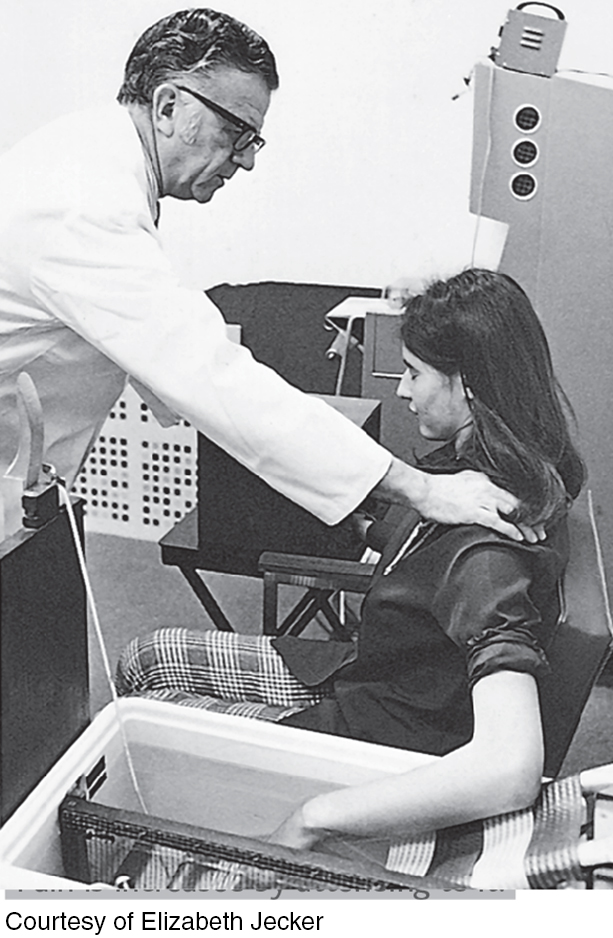
THINKING CRITICALLY ABOUT
Hypnosis and Pain Relief
Imagine you are about to be hypnotized. The hypnotist invites you to sit back, fix your gaze on a spot high on the wall, and relax. In a quiet, low voice the hypnotist suggests, “Your eyes are growing tired… . Your eyelids are becoming heavy … now heavier and heavier… . They are beginning to close… . You are becoming more deeply relaxed… . Your breathing is now deep and regular… . Your muscles are becoming more and more relaxed… . Your whole body is beginning to feel like lead.”
hypnosis a social interaction in which one person (the hypnotist) suggests to another (the subject) that certain perceptions, feelings, thoughts, or behaviors will spontaneously occur.
After a few minutes of this hypnotic induction, you may experience hypnosis. Hypnotists have no magical mind-
Can hypnosis relieve pain? Yes. When unhypnotized people put their arms in an ice bath, they felt intense pain within 25 seconds (Elkins et al., 2012; Jensen, 2008). When hypnotized people did the same after being given suggestions to feel no pain, they indeed reported feeling little pain. As some dentists know, light hypnosis can reduce fear, thus reducing hypersensitivity to pain. Hypnosis also lessens some forms of chronic pain (Adachi et al., 2014).
Hypnosis inhibits pain-
Psychologists have proposed two explanations for how hypnosis works. One theory proposes that hypnosis is a form of normal social influence (Lynn et al., 1990, 2015; Spanos & Coe, 1992). In this view, hypnosis is a by-
dissociation a split in consciousness, which allows some thoughts and behaviors to occur simultaneously with others.
posthypnotic suggestion a suggestion, made during a hypnosis session, to be carried out after the subject is no longer hypnotized; used by some clinicians to help control undesired symptoms and behaviors.
Another theory views hypnosis as a special dual-
Another form of dual processing—
RETRIEVE IT
Question
Which of the following has NOT been proven to reduce pain?
| A. |
| B. |
| C. |
| D. |
Taste
6-
Like touch, our sense of taste involves several basic sensations. Taste’s sensations were once thought to be sweet, sour, salty, and bitter, with all others stemming from mixtures of these four (McBurney & Gent, 1979). Then, as investigators searched for specialized nerve fibers for the four taste sensations, they encountered a receptor for what we now know is a fifth—
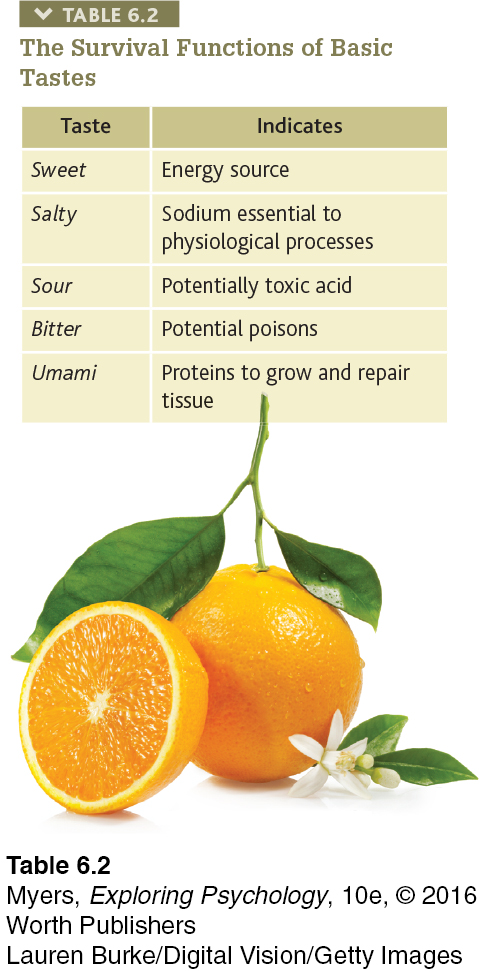
Tastes exist for more than our pleasure (see TABLE 6.2). Pleasureful tastes attracted our ancestors to energy-
Taste is a chemical sense. Inside each little bump on the top and sides of your tongue are 200 or more taste buds, each containing a pore that catches food chemicals. Into each taste bud pore, 50 to 100 taste receptor cells project antenna-
Taste receptors reproduce themselves every week or two, so if you burn your tongue with hot food it hardly matters. However, as you grow older, the number of taste buds decreases, as does taste sensitivity (Cowart, 1981). (No wonder adults enjoy strong-
“Life is not measured by the number of breaths we take, but by the moments that take our breath away.”
Author unknown
Essential as taste buds are, there’s more to taste than meets the tongue. Expectations can influence taste. When told a sausage roll was “vegetarian,” people in one experiment found it decidedly inferior to its identical partner labeled “meat” (Allen et al., 2008). In another experiment, being told that a wine cost $90 rather than its real $10 price made it taste better and triggered more activity in a brain area that responds to pleasant experiences (Plassmann et al., 2008).
Smell
Life begins with an inhale and ends with an exhale. Between birth and death, we will, on average, inhale and exhale 500 million breaths of life-
Impress your friends with your new word for the day: People unable to see are said to experience blindness. People unable to hear experience deafness. People unable to smell experience anosmia. The 1 in 7500 people born with anosmia not only have trouble cooking and eating, but also are somewhat more prone to depression, accidents, and relationship insecurity (Croy et al., 2012, 2013).
Like taste, smell is a chemical sense. We smell something when molecules of a substance carried in the air reach a tiny cluster of 20 million receptor cells at the top of each nasal cavity (FIGURE 6.43). These olfactory receptor cells, waving like sea anemones on a reef, respond selectively—

 For an animated explanation of how we smell, visit LaunchPad’s Concept Practice: Sense of Smell.
For an animated explanation of how we smell, visit LaunchPad’s Concept Practice: Sense of Smell.
Even nursing infants and their mothers have a literal chemistry to their relationship. They quickly learn to recognize each other’s scents (McCarthy, 1986). Aided by smell, a mother fur seal returning to a beach crowded with pups will find her own. Our human sense of smell is less acute than our senses of seeing and hearing. Looking out across a garden, we see its forms and colors in exquisite detail and hear a variety of birds singing, yet we smell little of it without sticking our nose into the blossoms.
Odor molecules come in many shapes and sizes—

For humans, the attractiveness of smells depends on learned associations (Herz, 2001). As babies nurse, their preference for the smell of their mother’s breast builds. So, too, with other associations. As good experiences are linked with a particular scent, people come to like that scent. This helps explain why people in the United States tend to like the smell of wintergreen (which they associate with candy and gum) more than do those in Great Britain (where it often is associated with medicine). In another example of odors evoking unpleasant emotions, researchers frustrated Brown University students with a rigged computer game in a scented room (Herz et al., 2004). Later, if exposed to the same odor while working on a verbal task, the students’ frustration was rekindled and they gave up sooner than others exposed to a different odor or no odor.
Our sensory experiences also interact with other aspects of our psychology. Our brain’s circuitry helps explain an odor’s power to evoke feelings and memories (FIGURE 6.44). A hotline runs between the brain area receiving information from the nose and the brain’s ancient limbic centers associated with memory and emotion. Thus, when put in a foul-
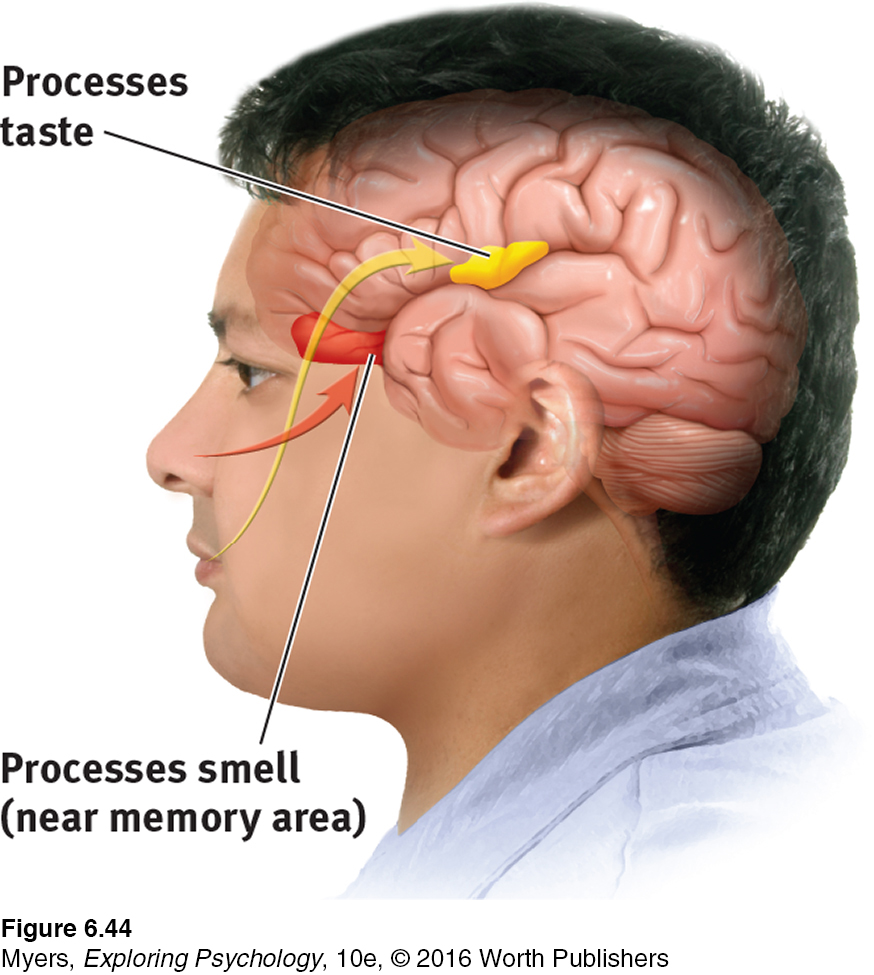
Though it’s difficult to recall odors by name, we can easily recognize long-
RETRIEVE IT
Question
How does our system for sensing smell differ from our sensory systems for touch and taste?
Body Position and Movement
6-
kinesthesia [kin-
vestibular sense the sense of body movement and position, including the sense of balance.
Important sensors in your joints, tendons, and muscles enable your kinesthesia—your sense of the position and movement of your body parts. By closing your eyes or plugging your ears you can momentarily imagine being without sight or sound. But what would it be like to live without touch or kinesthesia—
A companion vestibular sense monitors your head’s (and thus your body’s) position and movement. The biological gyroscopes for this sense of equilibrium are two structures in your inner ear. The first, your fluid-

If you twirl around and then come to an abrupt halt, neither the fluid in your semicircular canals nor your kinesthetic receptors will immediately return to their neutral state. The dizzy aftereffect fools your brain with the sensation that you’re still spinning. This illustrates a principle that underlies perceptual illusions: Mechanisms that normally give us an accurate experience of the world can, under certain conditions, fool us. Understanding how we get fooled provides clues to how our perceptual system works.
RETRIEVE IT
Question
Where are kinesthetic receptors and vestibular sense receptors located?
Sensory Interaction
6-
Our senses—
sensory interaction the principle that one sense may influence another, as when the smell of food influences its taste.
Thus, to savor a taste, we normally breathe the aroma through our nose—
Vision and hearing may similarly interact. A weak flicker of light is more easily visible when accompanied by a short burst of sound (Kayser, 2007). And a sound may be easier to hear with a visual cue. If I [DM], as a person with hearing loss, watch a video with simultaneous captioning, I have no trouble hearing the words I am seeing. I may therefore think I don’t need the captioning, but if I then turn off the captioning, I suddenly realize I do need it. The eyes guide the ears (FIGURE 6.45).
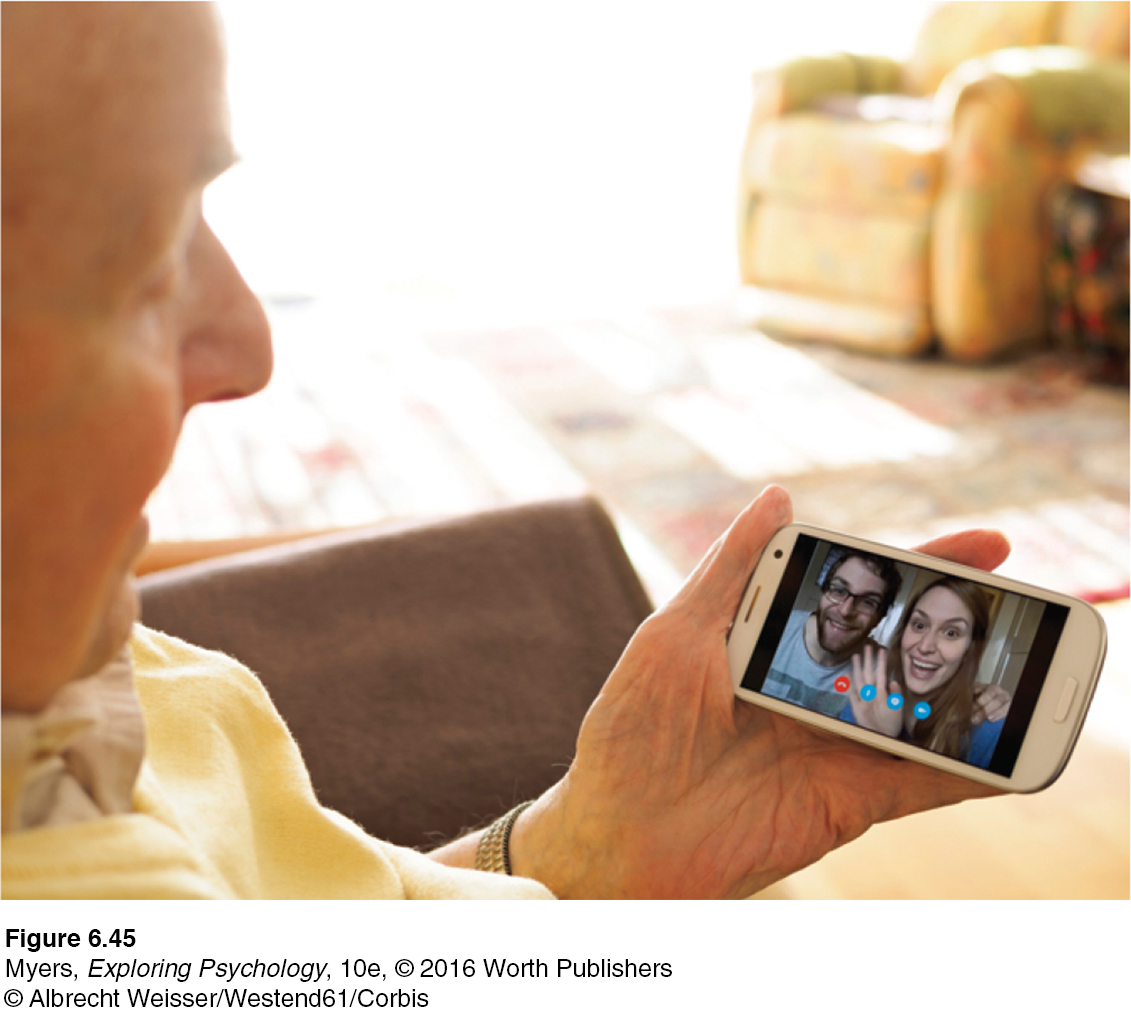
But what do you suppose happens if the eyes and the ears disagree? What if we see a speaker saying one syllable while we hear another? Surprise: We may perceive a third syllable that blends both inputs. Seeing the mouth movements for ga while hearing ba we may perceive da. This phenomenon is known as the McGurk effect, after its discoverers, Scottish psychologist Harry McGurk and his assistant John MacDonald (1976). For all of us, lip reading is part of hearing.
Touch also interacts with our other senses. In detecting events, the brain can combine simultaneous touch and visual signals, thanks to neurons projecting from the somatosensory cortex back to the visual cortex (Macaluso et al., 2000). Touch even interacts with hearing. In one experiment, researchers blew a puff of air (such as our mouths produce when saying pa and ta) on the neck or hands as people heard either these sounds or the more airless sounds ba or da. The result? People more often misheard ba or da as pa or ta when played with the faint puff (Gick & Derrick, 2009). Thanks to sensory interaction, they heard with their skin.
Our sensory experiences also interact with other aspects of our psychology. Our brain even blends our tactile and social judgments, as demonstrated in these playful experiments:
After holding a warm drink rather than a cold one, people were more likely to rate someone more warmly, feel closer to them, and behave more generously (IJzerman & Semin, 2009; Williams & Bargh, 2008). Physical warmth promotes social warmth.
After being given the cold shoulder by others in an experiment, people judge the room as colder than do those treated warmly (Zhong & Leonardelli, 2008). Social exclusion literally feels cold.
Sitting at a wobbly desk and chair makes others’ relationships seem less stable (Kille et al., 2013).
When leaning to the left—
by sitting in a left- rather than right- leaning chair, or squeezing a hand- grip with their left hand, or using a mouse with their left hand— people lean more left in their expressed political attitudes (Oppenheimer & Trail, 2010). When holding a soft ball, American students become more likely to categorize a face as a Democrat rather than a Republican, and vice versa when holding a hard ball (Slepian et al., 2012).
 IMMERSIVE LEARNING Are you wondering how researchers test these kinds of questions? Try LaunchPad’s How Would You Know If a Cup of Coffee Can Warm Up Relationships?
IMMERSIVE LEARNING Are you wondering how researchers test these kinds of questions? Try LaunchPad’s How Would You Know If a Cup of Coffee Can Warm Up Relationships?
embodied cognition the influence of bodily sensations, gestures, and other states on cognitive preferences and judgments.
These examples of embodied cognition illustrate how brain circuits processing bodily sensations connect with brain circuits responsible for cognition. We think from within a body.
So, the senses interact: As we attempt to decipher our world, our brain blends inputs from multiple channels. For many people, an odor, perhaps of mint or chocolate, can evoke a sensation of taste (Stevenson & Tomiczek, 2007). But in a few select individuals, the senses become joined in a phenomenon called synesthesia, where one sort of sensation (such as hearing sound) involuntarily produces another (such as seeing color). Thus, hearing music may activate color-
* * *
For a summary of our sensory systems, see TABLE 6.3. The river of perception is fed by streams of sensation, cognition, and emotion.
If perception is the product of these three sources, what can we say about extrasensory perception, which claims that perception can occur apart from sensory input? For more on that question, see Thinking Critically About: ESP—
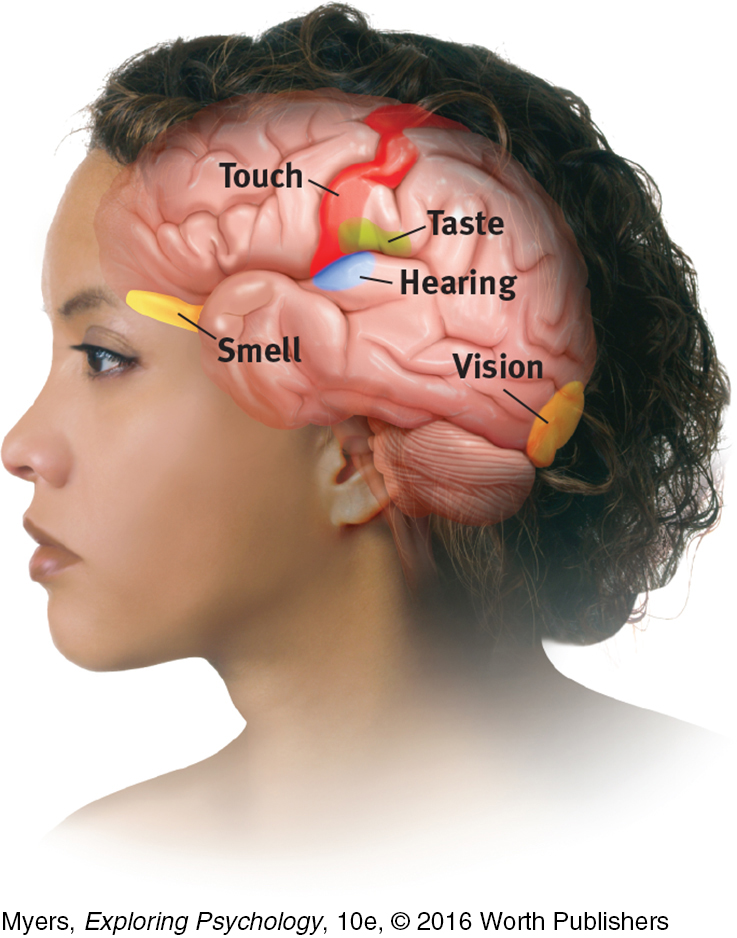
Summarizing the Senses
| Sensory System | Source | Receptors | Key Brain Areas |
|---|---|---|---|
| Vision | Light waves striking the eye | Rods and cones in the retina | Occipital lobes |
| Hearing | Sound waves striking the outer ear | Cochlear hair cells in the inner ear | Temporal lobes |
| Touch | Pressure, warmth, cold | Receptors, most in the skin, detect pressure, warmth, cold, and pain | Somatosensory cortex |
| Taste | Chemical molecules in the mouth | Basic tongue receptors for sweet, sour, salty, bitter, and umami | Frontal temporal lobe border |
| Smell | Chemical molecules breathed in through the nose | Millions of receptors at top of nasal cavity | Olfactory bulb |
| Body position— |
Any change in position of a body part, interacting with vision | Kinesthetic sensors in joints, tendons, and muscles | Cerebellum |
| Body movement— |
Movement of fluids in the inner ear caused by head/body movement | Hair- |
Cerebellum |
THINKING CRITICALLY ABOUT
ESP—
6-
extrasensory perception (ESP) the controversial claim that perception can occur apart from sensory input; includes telepathy, clairvoyance, and precognition.
Without sensory input, are we capable of extrasensory perception (ESP)? Are there indeed people—
The most testable and, for this discussion, most relevant ESP claims are
telepathy: mind-
to- mind communication. clairvoyance: perceiving remote events, such as a house on fire in another state.
precognition: perceiving future events, such as an unexpected death in the next month.
Closely linked is psychokinesis, or “mind movement,” such as levitating a table or influencing the roll of a die. (The claim is illustrated by the wry request, “Will all those who believe in psychokinesis please raise my hand?”)
If ESP is real, we would need to overturn the scientific understanding that we are creatures whose minds are tied to our physical brains and whose perceptual experiences are built of sensations. Sometimes new evidence does overturn our scientific preconceptions.
parapsychology the study of paranormal phenomena, including ESP and psychokinesis.
Most research psychologists and scientists have been skeptical that paranormal phenomena exist. But in several reputable universities, parapsychology researchers perform scientific experiments searching for possible ESP (Storm, 2010a, b; Turpin, 2005). Before seeing how they do so, let’s consider some popular beliefs.
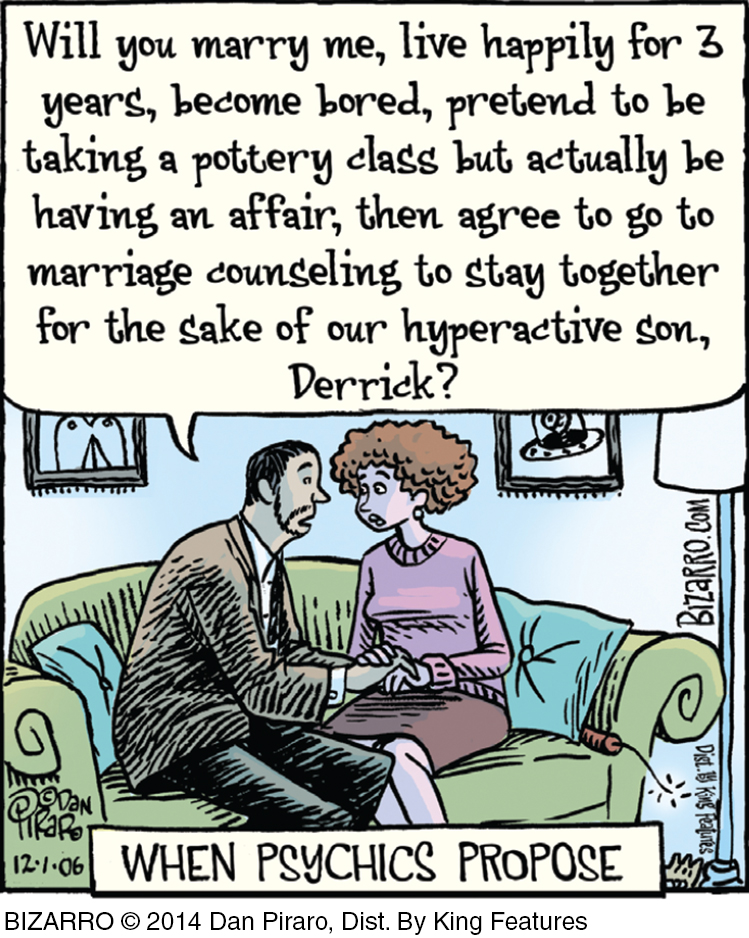
Premonitions or Pretensions?
Can psychics see into the future? Although one might wish for a psychic stock forecaster, the tallied forecasts of “leading psychics” reveal meager accuracy. During the 1990s, the tabloid psychics were all wrong in predicting surprising events. (Madonna did not become a gospel singer, the Statue of Liberty did not lose both its arms in a terrorist blast, Queen Elizabeth did not abdicate her throne to enter a convent.) And the psychics have missed big-
The psychic visions offered to police departments have been no more accurate than guesses made by others (Nickell, 1994, 2005; Radford, 2010; Reiser, 1982). Their sheer volume does, however, increase the odds of an occasional correct guess, which psychics can then report to the media. Police departments are wise to all this. When researchers asked the police departments of America’s 50 largest cities whether they ever had used psychics, 65 percent said No (Sweat & Durm, 1993). Of those that had, not one had found them helpful.
Psychics’ vague predictions sometimes sound correct when later retrofitted to match events. Nostradamus, a sixteenth-
Are the spontaneous “visions” of everyday people any more accurate? Do dreams, for example, foretell the future, as people from both Eastern and Western cultures tend to believe—
Given the billions of events in the world each day, and given enough days, some stunning coincidences are sure to occur. By one careful estimate, chance alone would predict that more than a thousand times a day someone on Earth will think of another person and then, within the next five minutes, learn of that person’s death (Charpak & Broch, 2004). Thus, when explaining an astonishing event, we should “give chance a chance” (Lilienfeld, 2009). With enough time and people, the improbable becomes inevitable.
Putting ESP to Experimental Test
When faced with claims of mind reading or out-
This scientific attitude has led both believers and skeptics to agree that what parapsychology needs is a reproducible phenomenon and a theory to explain it. Parapsychologist Rhea White (1998) spoke for many in saying “The image of parapsychology that comes to my mind, based on nearly 44 years in the field, is that of a small airplane [that] has been perpetually taxiing down the runway of the Empirical Science Airport since 1882 … its movement punctuated occasionally by lifting a few feet off the ground only to bump back down on the tarmac once again. It has never taken off for any sustained flight.”
“To be sure of hitting the target, shoot first and call whatever you hit the target.”
Writer-
“A person who talks a lot is sometimes right.”
Spanish proverb
How might we test ESP claims in a controlled, reproducible experiment? An experiment differs from a staged demonstration. In the laboratory, the experimenter controls what the “psychic” sees and hears; on stage, the psychic controls what the audience sees and hears.
Daryl Bem, a respected social psychologist, has been a skeptic of stage psychics; he once quipped that “a psychic is an actor playing the role of a psychic” (1984). Yet he reignited hopes for replicable evidence with nine experiments that seemed to show people anticipating future events (2011). In one, when an erotic scene was about to be displayed in one of two randomly selected screen placements, Cornell University participants guessed the right placement 53.1 percent of the time (beating 50 percent by a small but statistically significant margin).
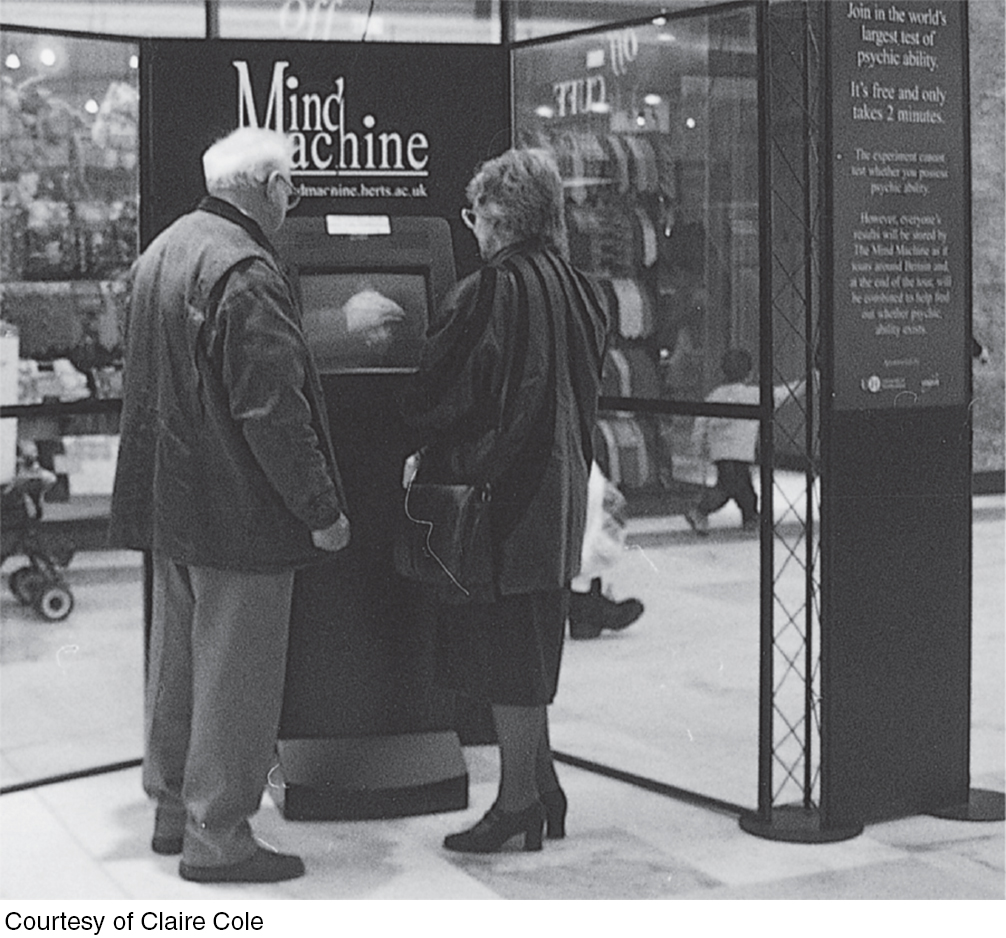
Despite Bem’s published research having survived critical reviews by a top-
Anticipating such skepticism, Bem has made his computer materials available to anyone who wishes to replicate his studies. Multiple attempts have since been made, with minimal success and continuing controversy (Bem et al., 2014; Galak et al., 2012; Ritchie et al., 2012; Wagenmakers, 2014). Regardless, science is doing its work. It has been open to a finding that challenges its own assumptions. And then, through follow-
“At the heart of science is an essential tension between two seemingly contradictory attitudes—
Carl Sagan (1987)
One skeptic, magician James Randi, has had a long-
RETRIEVE IT
Question
If an ESP event occurred under controlled conditions, what would be the next best step to confirm that ESP really exists?
* * *
To feel awe, mystery, and a deep reverence for life, we need look no further than our own perceptual system and its capacity for organizing formless nerve impulses into colorful sights, vivid sounds, and evocative smells. As Shakespeare’s Hamlet recognized, “There are more things in Heaven and Earth, Horatio, than are dreamt of in your philosophy.” Within our ordinary sensory and perceptual experiences lies much that is truly extraordinary—
Learning Objectives
Test Yourself by taking a moment to answer each of these Learning Objective Questions (repeated here from within the chapter). Research suggests that trying to answer these questions on your own will improve your long-
Question
6-
Question
6-
Question
6-
Question
6-
Question
6-
Question
6-
Question
6-
Question
6-
Question
6-
Terms and Concepts to Remember
Test yourself on these terms.
Question
audition (p. 226) frequency (p. 226) pitch (p. 226) middle ear (p. 227) cochlea [KOHK- inner ear (p. 228) sensorineural hearing loss (p. 228) conduction hearing loss (p. 228) cochlear implant (p. 229) place theory (p. 229) frequency theory (p. 230) gate- hypnosis (p. 235) dissociation (p. 235) posthypnotic suggestion (p. 235) kinesthesia [kin- vestibular sense (p. 238) sensory interaction (p. 239) embodied cognition (p. 240) extrasensory perception (ESP) (p. 241) parapsychology (p. 241) | the controversial claim that perception can occur apart from sensory input; includes telepathy, clairvoyance, and precognition. a tone's experienced highness or lowness; depends on frequency. in hearing, the theory that the rate of nerve impulses traveling up the auditory nerve matches the frequency of a tone, thus enabling us to sense its pitch. (Also called temporal theory.) the sense or act of hearing. a social interaction in which one person (the hypnotist) suggests to another (the subject) that certain perceptions, feelings, thoughts, or behaviors will spontaneously occur. less common form of hearing loss, caused by damage to the mechanical system that conducts sound waves to the cochlea. the innermost part of the ear, containing the cochlea, semicircular canals, and vestibular sacs. the most common form of hearing loss, also called nerve deafness; caused by damage to the cochlea's receptor cells or to the auditory nerves. the theory that the spinal cord contains a neurological "gate" that blocks pain signals or allows them to pass on to the brain. The "gate" is opened by the activity of pain signals traveling up small nerve fibers and is closed by activity in larger fibers or by information coming from the brain. the sense of body movement and position, including the sense of balance. in hearing, the theory that links the pitch we hear with the place where the cochlea's membrane is stimulated. the number of complete wavelengths that pass a point in a given time (for example, per second). the chamber between the eardrum and cochlea containing three tiny bones (hammer, anvil, and stirrup) that concentrate the vibrations of the eardrum on the cochlea's oval window. a suggestion, made during a hypnosis session, to be carried out after the subject is no longer hypnotized; used by some clinicians to help control undesired symptoms and behaviors. the system for sensing the position and movement of individual body parts. the principle that one sense may influence another, as when the smell of food influences its taste. the study of paranormal phenomena, including ESP and psychokinesis. a split in consciousness, which allows some thoughts and behaviors to occur simultaneously with others. a device for converting sounds into electrical signals and stimulating the auditory nerve through electrodes threaded into the cochlea. the influence of bodily sensations, gestures, and other states on cognitive preferences and judgments. a coiled, bony, fluid- |
Experience the Testing Effect
Test yourself repeatedly throughout your studies. This will not only help you figure out what you know and don’t know; the testing itself will help you learn and remember the information more effectively thanks to the testing effect.
Question 6.24
1. The snail-
Question 6.25
2. What are the basic steps in transforming sound waves into perceived sound?
Question 6.26
3. theory explains how we hear high-pitched sounds, and theory explains how we hear low-pitched sounds.
Question 6.27
4. The gate-control theory of pain proposes that
| A. |
| B. |
| C. |
| D. |
Question 6.28
5. How does the biopsychosocial approach explain our experience of pain? Provide examples.
Question 6.29
6. We have specialized nerve receptors for detecting which five tastes? How did this ability aid our ancestors?
Question 6.30
7. is your sense of body position and movement. Your specifically monitors your head's movement, with sensors in the inner ear.
Question 6.31
8. Why do you feel a little dizzy immediately after a roller-coaster ride?
Question 6.32
9. A food's aroma can greatly enhance its taste. This is an example of
| A. |
| B. |
| C. |
| D. |
Question 6.33
10. Which of the following ESP phenomena is supported by solid, replicable scientific evidence?
| A. |
| B. |
| C. |
| D. |
Use  to create your personalized study plan, which will direct you to the resources that will help you most in
to create your personalized study plan, which will direct you to the resources that will help you most in  .
.